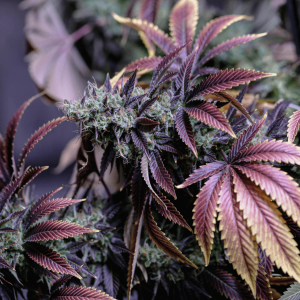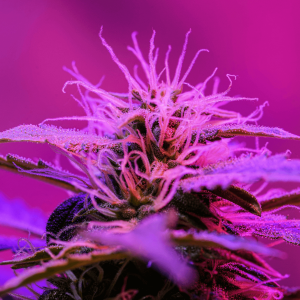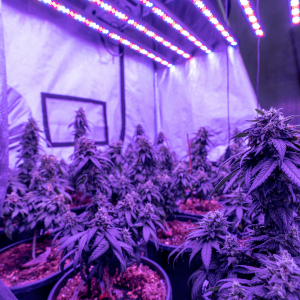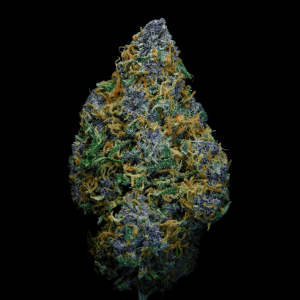Cannabinoids are the various active chemical compounds found in the hemp plant, and two of the lesser-known but increasingly popular ones are CBN (Cannabinol) and CBG (Cannabigerol). And in the battle between CBN vs CBG, you may be asking yourself: What’s the difference?
With so much buzz around CBD and THC, it’s easy to overlook these minor cannabinoids that offer their own unique benefits. Understanding the differences between CBN and CBG is important because each cannabinoid interacts with the body’s endocannabinoid system in distinct ways, influencing everything from sleep patterns to pain management.
In this blog, we’ll dive into the specifics of CBN and CBG, comparing their properties, potential benefits, and how they each may fit into your wellness routine. So, whether you’re a seasoned cannabis user or just curious about its therapeutic potential, read on to get the comprehensive lowdown on CBN vs CBG.
What Are Cannabinoids?
Cannabinoids are naturally occurring compounds found in the cannabis plant, and they play a crucial role in the plant’s interaction with our bodies.
These compounds, including the well-known THC and CBD, as well as lesser-known ones like CBN and CBG, influence how we experience cannabis. At the heart of this interaction is the endocannabinoid system (ECS), a complex cell-signaling system within our bodies that helps regulate various functions such as mood, sleep, appetite, and pain.
When cannabinoids enter the bloodstream, they interact with ECS cannabinoid receptors to produce psychoactive effects. This unique interplay is what makes cannabinoids so intriguing and why they have gained significant attention for their potential therapeutic benefits.

Understanding CBN (Cannabinol)
CBN, or Cannabinol, is one of the many cannabinoids found in the cannabis plant. Chemically, CBN is a mildly psychoactive compound that is produced as THC (Tetrahydrocannabinol) degrades. This degradation typically occurs over time and when cannabis is exposed to air and light, which is why older cannabis or improperly stored cannabis tends to have higher levels of CBN.
Structurally, CBN is quite similar to THC, but small differences in the chemical bonds result in different effects on the body.
When it comes to natural sources, you can find CBN in cannabis that has been aged or exposed to outdoor elements, as well as in certain forms of processed hemp.
Understanding CBG (Cannabigerol)
CBG, or Cannabigerol, is often referred to as the “mother of all cannabinoids” because it serves as the precursor to other cannabinoids like THC and CBD.
Initially, the hemp plant produces CBGA, the acidic form of CBG, which then breaks down to form the three main cannabinoid lines: THCA, CBDA, and CBCA. Through decarboxylation, these acids convert to THC, CBD, and CBC, respectively, but a small amount remains as CBG. Chemically, CBG has a unique structure with its own specific set of effects.
As for its natural sources, CBG is typically found in low concentrations in most cannabis strains. However, certain strains are bred specifically to yield higher CBG content, making it more accessible for extraction and use.
History of CBN
The discovery of CBN dates back to the early days of cannabinoid research. CBN was actually the first cannabinoid to be isolated from the cannabis plant, with its identification occurring in the late 19th century. Early researchers noticed that aged cannabis seemed to have different effects compared to fresh plant material, which led to the discovery of CBN as a product of THC degradation.
Initial studies from the early to mid-20th century revealed the mildly psychoactive nature of CBN, distinguishing it from its more famous cousin, THC.
Historically, CBN wasn’t just a scientific curiosity; it was also used in ancient medicinal practices, where aged cannabis was often utilized for its potentially therapeutic effects.
Benefits of CBN
CBN has been gaining attention for its array of potential benefits, especially as a sleep aid. Many users report that CBN helps them fall asleep faster and stay asleep longer, making it a natural alternative to traditional sleep medications.
Beyond its sedative properties, CBN also shows promise as a pain reliever. Studies have indicated that CBN may interact with the body’s endocannabinoid system to help alleviate pain and reduce inflammation. This makes it an option worth exploring for those dealing with chronic pain or inflammatory conditions.
Another interesting benefit of CBN is its potential to stimulate appetite, which could be particularly useful for patients undergoing treatments like chemotherapy that often suppress appetite.

History of CBG
The discovery of CBG traces back to the pioneering days of cannabinoid research in the mid-20th century. While THC and CBD initially stole the spotlight, scientists were intrigued by the presence of other cannabinoids in the cannabis plant, including THCa, and CBG.
CBG was identified as the precursor to many well-known cannabinoids, earning it the nickname “the mother of all cannabinoids.” Early studies focused on understanding its role within the plant and how it contributed to the biosynthesis of other cannabinoids. Researchers discovered that CBGA, the acidic form of CBG, is the starting point for THC, CBD, CBC, and THCa, thus underscoring its importance in the plant’s chemical makeup.
Historically, CBG hasn’t been as extensively used or studied as other cannabinoids like THC, CBD, or even THCa, mainly due to its low natural concentration in most cannabis strains. Nonetheless, its foundational role in the cannabinoid family tree makes it a subject of significant interest.
Benefits of CBG
CBG is not just a foundational cannabinoid; it also boasts several notable benefits. One of its standout properties is its neuroprotective effects. Some studies suggest that CBG may protect nerve cells from damage and degeneration, offering potential therapeutic applications for neurodegenerative diseases like Huntington’s disease and multiple sclerosis.
Additionally, CBG has demonstrated potent antibacterial properties, particularly against resistant bacterial strains like MRSA, making it a promising candidate for new antibiotic therapies. Its anti-inflammatory properties present another key benefit, offering potential relief for conditions characterized by inflammation, such as inflammatory bowel disease and arthritis.
On top of these, CBG has shown promise in treating glaucoma by reducing intraocular pressure, thus providing a potential alternative to conventional glaucoma treatments.
Collectively, these benefits highlight CBG’s multifaceted therapeutic potential, paving the way for more targeted research and applications.
Differences in Chemical Structure
When diving into the structural differences between CBN and CBG, it’s fascinating to see how small variations can lead to distinct effects on the body.
CBN is created from the oxidation and decomposition of THC, which means it carries over some similarities in structure but also notable differences. Over time, as THC ages and is exposed to oxygen, it transforms into CBN, thereby altering its psychoactive properties.
On the other hand, CBG starts as CBGA, the acidic form, and acts as a chemical precursor to other cannabinoids. This foundational role means CBG maintains a more constant structure, influencing its stability and function.
These structural variations are crucial because they dictate how each cannabinoid interacts with the body’s endocannabinoid system. While CBN may excel in sedative and pain-relief properties due to its broken-down state, CBG’s stable structure lends itself to neuroprotective and antibacterial effects. Understanding these differences not only enriches our knowledge of these cannabinoids but also helps in tailoring specific applications for health and wellness.
Methods of Extraction
Common Methods for Extracting CBN
Extracting CBN typically involves a few key methods, each with its own set of advantages and challenges. One of the most common methods is CO2 extraction. This technique uses pressurized carbon dioxide to pull out the cannabinoids, resulting in a clean and pure extract. CO2 extraction is valued for its safety and efficiency, making it a popular choice for large-scale operations.
Another widely used method is ethanol extraction. In this process, ethanol is used as a solvent to dissolve the cannabinoids from the plant material. The solution is then filtered, and the ethanol is evaporated, leaving behind a concentrated CBN extract. Ethanol extraction is known for its cost-effectiveness and is often employed by smaller producers.
A newer but increasingly popular method is solventless or rosin extraction. This technique uses heat and pressure to extract cannabinoids without the use of chemicals. It’s a more natural approach that’s gaining traction, especially among those looking for a purer product.
Common Methods for Extracting CBG
Similar to CBN, CBG can be extracted using several methods. CO2 extraction is again a primary method due to its ability to produce high-quality, contaminant-free extracts. This method is particularly effective for preserving CBG’s delicate properties.
Another common method is hydrocarbon extraction, which uses solvents like butane or propane to extract CBG. This technique is highly efficient and capable of yielding a rich extract, but it requires meticulous purification to ensure no residual solvents remain.
Like CBN, ethanol extraction is also a viable option for CBG. It’s straightforward and cost-effective, making it accessible for various scales of production. However, careful management is required to maintain the integrity and purity of the CBG extract.
Comparing Extraction Processes
While both CBN and CBG can be extracted using CO2, ethanol, and other methods, there are nuances that make each extraction unique. CO2 extraction stands out for its ability to produce high-quality, pure extracts for both CBN and CBG, though it requires significant investment in equipment. Ethanol extraction, although more cost-effective, needs diligent post-processing to remove any residual solvents and preserve the cannabinoid’s quality.
Hydrocarbon extraction, more commonly used for CBG than CBN, offers high efficiency but brings with it the challenge of ensuring complete solvent removal. Solventless extraction, favored for its purity, is emerging as a promising method, particularly for small batches.
Ultimately, choosing the appropriate extraction method depends on factors like scale, cost, and the desired purity of the final product. Understanding these methods helps producers and consumers alike to appreciate the intricacies involved in bringing these beneficial cannabinoids from plant to product.

Legal Status
The legal status of CBN and CBG varies widely across different regions, creating a complex situation for consumers and producers.
In the United States, the 2018 Farm Bill legalized hemp-derived cannabinoids, including CBN and CBG, as long as they contain less than 0.3% THC. However, individual states have their own regulations, some more restrictive than others. For example, while CBG is generally accepted, the psychoactive nature of CBN—derived from THC—can complicate its legal status in certain areas.
In the European Union, the guidelines also differ. Although the European Industrial Hemp Association supports the sale of hemp-based products, each country has its own rules regarding cannabinoid content and usage.
In Canada, both CBN and CBG are allowed under the Cannabis Act, but they must meet strict regulatory standards. Legislative changes continue to shape the landscape, with ongoing research and shifting public opinions gradually influencing policymakers.
Staying updated on these evolving laws is crucial for anyone involved in the cannabinoid market.
Side Effects and Safety
Potential Side Effects of CBN
Like any compound, CBN isn’t without its potential side effects. The most commonly reported side effects of CBN include drowsiness, fatigue, and dizziness. These intoxicating effects are largely due to CBN’s sedative properties, which can be beneficial for those seeking sleep aids but less ideal for daytime use.
Research on the long-term effects of CBN is still in the early stages, but preliminary studies indicate it has a good safety profile at low to moderate doses. To mitigate side effects, it’s advisable to start with a low dose and gradually increase as needed, giving your body time to adjust.
Additionally, using CBN at night can help minimize disruptions to daytime activities.
Potential Side Effects of CBG
CBG is generally considered to be well-tolerated, but it’s not entirely free from side effects. Common side effects of CBG may include dry mouth, low blood pressure, and increased appetite. While these effects are typically mild and short-lived, they can be inconvenient.
Current research into the long-term effects of CBG is limited, though existing studies suggest it has a favorable safety profile similar to other non-psychoactive cannabinoids. To reduce potential side effects, it’s recommended to start with a small dose of CBG and monitor your body’s response, adjusting the dosage as necessary.
Staying hydrated and consuming the cannabinoid alongside food can also help in mitigating some of its side effects.
Research and Studies on CBN
Though still in its early stages, research into CBN has shown promising results. Key studies indicate its potential as a sedative, making it an interesting candidate for sleep aid medications. One notable study found that CBN, especially when combined with THC, enhances sedation, aiding those with insomnia and other sleep disorders.
Preliminary research also suggests that CBN may have anti-inflammatory and pain-relieving properties, hinting at broader therapeutic uses. Despite these encouraging findings, CBN research is still in its infancy, with many studies relying on animal models or limited human trials.
Future research aims to address these gaps with comprehensive clinical trials to validate CBN’s efficacy and safety in humans. Researchers are particularly interested in its mechanisms in pain management and potential neuroprotective effects.
As the legal landscape evolves, increased funding and scientific interest are expected to drive further studies. Understanding how CBN interacts with other cannabinoids and the endocannabinoid system could unlock new possibilities for medical treatments and health supplements.
Research and Studies on CBG
Similar to CBN, research on CBG is growing with promising results. Anecdotal evidence has shown CBG’s potential in treating inflammatory bowel disease (IBD) and glaucoma. A pivotal study from 2013 found that CBG could reduce inflammation in animal models of IBD, suggesting therapeutic potential for humans. Another study highlighted CBG’s effectiveness in lowering intraocular pressure, making it a potential treatment for glaucoma. These early findings showcase CBG’s versatility in addressing various health issues.
Currently, CBG research is still developing with a focus on preclinical studies. Scientists are working to understand its pharmacological profile and safety for long-term use. Future research aims to explore CBG’s neuroprotective properties and its potential benefits for conditions like Huntington’s disease and multiple sclerosis.
As interest in cannabinoids grows, upcoming studies will likely include more robust clinical trials to confirm CBG’s therapeutic promises and establish comprehensive safety guidelines.

CBN vs CBG: Efficacy Comparisons
When it comes to efficacy and potential health benefits, both CBN and CBG have shown promise, but they shine in different areas.
CBN, known for its strong sedative properties, is often touted as an effective sleep aid, particularly when used in oils or capsules. On the other hand, CBG is frequently highlighted for its anti-inflammatory and pain-relieving effects, making it a popular choice for those tackling conditions like IBD or glaucoma.
The form in which these cannabinoids are consumed also plays a role—oils and capsules provide systemic effects, while topicals are excellent for localized relief. For instance, a CBG-infused cream can be particularly effective for targeted pain management, whereas a CBN oil might be better suited for overall relaxation and sleep support.
Product Forms and Administration
Various Forms of CBN Products
- Oils: Easily absorbed and can be mixed with food or drinks.
- Edibles: Gummies, chocolates, and infused snacks; convenient for on-the-go use.
- Capsules: Offers precise dosing and are simple to incorporate into daily routines.
Various Forms of CBG Products
- Oils: Versatile, can be taken directly or added to recipes.
- Edibles: Available in gummies, cookies, and other tasty forms.
- Capsules: Provide consistent dosing and are discreet for daily consumption.
Best Methods of Administration
- CBN Oils: Best taken sublingually (under the tongue) for quick absorption.
- CBN Edibles: Ideal for those who prefer a tasty and discreet option, though effects may take longer to set in.
- CBN Capsules: Great for those looking for a no-fuss, precise dosage, especially when taken with food.
- CBG Oils: Recommended to be taken sublingually to maximize absorption rates.
- CBG Edibles: Perfect for gradual release and enjoyable consumption, with delayed onset of effects.
- CBG Capsules: Optimal for steady, long-lasting relief and easy addition to your supplement regimen.
Combining CBN and CBG
When CBN and CBG are combined, they may produce an enhanced effect known as the entourage effect.
This phenomenon suggests that cannabinoids can work more effectively together than when used individually, potentially amplifying their therapeutic benefits. By leveraging the entourage effect, users might experience a more comprehensive approach to wellness.
Potential Benefits of Combining CBN and CBG
Syncing up CBN’s sedative properties with CBG’s anti-inflammatory and pain-relieving effects could provide a well-rounded solution for various health issues.
This combination might be particularly beneficial for those seeking relief from chronic pain, sleep disorders, and inflammation all at once. For instance, users might find it easier to manage pain and achieve restful sleep simultaneously by using a product that blends both cannabinoids.
Product Examples Offering Combined Benefits
Many manufacturers offer products that harness the combined benefits of CBN and CBG. For example, some tinctures or oils are specifically crafted to include both cannabinoids, aiming to provide a balanced and synergistic effect.
Other options include capsules and edibles that combine these potent compounds, offering convenient and versatile ways to incorporate both CBN and CBG into a wellness routine.

Conclusion
To wrap things up, we’ve taken a deep dive into the growing body of research surrounding CBN and CBG, exploring their unique properties and therapeutic potentials. While CBN is championed for its sedative and sleep-enhancing capabilities, CBG stands out for its anti-inflammatory and pain-relieving benefits.
We’ve also discussed various product forms like oils, edibles, and capsules, and highlighted how combining these cannabinoids can provide a more holistic approach to wellness through the entourage effect. As with any supplement, the importance of further research cannot be overstated—robust clinical trials are essential to fully understand the long-term safety and efficacy of these compounds.
Personal experimentation, under professional guidance, can help individuals discover which cannabinoid and product form works best for their unique needs. In this exciting landscape of cannabinoid research, both CBN and CBG offer promising avenues for enhancing health and well-being.
Frequently Asked Questions
What is better, CBN or CBG?
Determining whether CBN vs CBG is better really depends on your individual needs and what you’re looking to achieve. CBN is well-known for its calming and sleep-inducing properties, making it a go-to choice for those struggling with sleep issues or needing relaxation. On the flip side, CBG is celebrated for its anti-inflammatory and pain-relieving benefits, often used by individuals managing chronic pain or inflammation-related conditions. So, if sleep and relaxation are your goals, CBN might be better for you. If pain management is your primary concern, CBG could be more effective.
What is CBN best for?
CBN is best known for its sedative properties and is often used as a sleep aid. It can help people with insomnia or anyone who has trouble falling and staying asleep. Besides promoting better sleep, CBN is also being researched for its potential anti-inflammatory and pain-relieving effects, although these aren’t its primary uses. Overall, CBN’s main claim to fame is improving sleep quality and helping with relaxation.
How does CBG make you feel?
CBG generally makes you feel more balanced and at ease. Unlike THC, it doesn’t have psychoactive effects, so you won’t feel “high” or altered. Instead, users often report feeling a sense of overall wellness and relief from discomfort. Its anti-inflammatory properties can help reduce pain, making you feel more comfortable. Additionally, some people find that CBG helps improve their mood and focus, contributing to a general feeling of well-being.
Which is better for pain, CBD or CBG?
When it comes to pain relief, both CBD and CBG have their merits, but CBG might have an edge in certain scenarios. CBD is widely recognized for its anti-inflammatory and analgesic properties and is commonly used for various types of pain, including chronic conditions like arthritis. CBG, however, is emerging as a potent anti-inflammatory and pain-relieving agent, particularly effective for specific conditions such as inflammatory bowel disease (IBD) and glaucoma. Ultimately, the better option may come down to personal preference and specific health needs, and some users find that combining both cannabinoids offers enhanced pain relief.

 Rewards
Rewards




